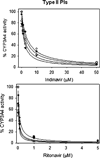Differential effects of ethanol on spectral binding and inhibition of cytochrome P450 3A4 with eight protease inhibitors antiretroviral drugs
- PMID: 21682753
- PMCID: PMC4082664
- DOI: 10.1111/j.1530-0277.2011.01575.x
Differential effects of ethanol on spectral binding and inhibition of cytochrome P450 3A4 with eight protease inhibitors antiretroviral drugs
Abstract
Background: Cytochrome P450 3A4 (CYP3A4) is the most abundant CYP enzyme in the liver, which metabolizes approximately 50% of the marketed drugs including antiretroviral agents. CYP3A4 induction by ethanol and its impact on drug metabolism and toxicity is known. However, CYP3A4-ethanol physical interaction and its impact on drug binding, inhibition, or metabolism is not known, except that we have recently shown that ethanol facilitates the binding of a protease inhibitor (PI), nelfinavir, with CYP3A4. The current study was designed to examine the effect of ethanol on spectral binding and inhibition of CYP3A4 with all currently used PIs that differ in physicochemical properties.
Methods: We performed type I and type II spectral binding with CYP3A4 at 0 and 20 mM ethanol and varying PIs' concentrations. We also performed CYP3A4 inhibition using 7-benzyloxy-4-trifluoromethylcoumarin substrate and NADPH at varying concentrations of PIs and ethanol.
Results: Atazanavir, lopinavir, saquinavir, and tipranavir showed type I spectral binding, whereas indinavir and ritonavir showed type II. However, amprenavir and darunavir did not show spectral binding with CYP3A4. Ethanol at 20 mM decreased the maximum spectral change (δA(max)) with type I lopinavir and saquinavir, but it did not alter δA(max) with other PIs. Ethanol did not alter spectral binding affinity (K(D)) and inhibition constant (IC(50)) of type I PIs. However, ethanol significantly decreased the IC(50) of type II PIs, indinavir and ritonavir, and markedly increased the IC(50) of amprenavir and darunavir.
Conclusions: Overall, our results suggest that ethanol differentially alters the binding and inhibition of CYP3A4 with the PIs that have different physicochemical properties. This study has clinical relevance because alcohol has been shown to alter the response to antiretroviral drugs, including PIs, in HIV-1-infected individuals.
Copyright © 2011 by the Research Society on Alcoholism.
Figures




Similar articles
-
Effect of ethanol on spectral binding, inhibition, and activity of CYP3A4 with an antiretroviral drug nelfinavir.Biochem Biophys Res Commun. 2010 Nov 5;402(1):163-7. doi: 10.1016/j.bbrc.2010.10.014. Epub 2010 Oct 16. Biochem Biophys Res Commun. 2010. PMID: 20937259
-
Effect of Methamphetamine on Spectral Binding, Ligand Docking and Metabolism of Anti-HIV Drugs with CYP3A4.PLoS One. 2016 Jan 7;11(1):e0146529. doi: 10.1371/journal.pone.0146529. eCollection 2016. PLoS One. 2016. PMID: 26741368 Free PMC article.
-
Combination of protease inhibitors for the treatment of HIV-1-infected patients: a review of pharmacokinetics and clinical experience.Antivir Ther. 2001 Dec;6(4):201-29. Antivir Ther. 2001. PMID: 11878403 Review.
-
Analysis of CYP3A4-HIV-1 protease drugs interactions by computational methods for Highly Active Antiretroviral Therapy in HIV/AIDS.J Mol Graph Model. 2010 Jan;28(5):455-63. doi: 10.1016/j.jmgm.2009.10.005. Epub 2009 Oct 30. J Mol Graph Model. 2010. PMID: 19931478
-
Darunavir: a review of its use in the management of HIV infection in adults.Drugs. 2009;69(4):477-503. doi: 10.2165/00003495-200969040-00007. Drugs. 2009. PMID: 19323590 Review.
Cited by
-
An update on drug-drug interactions between antiretroviral therapies and drugs of abuse in HIV systems.Expert Opin Drug Metab Toxicol. 2020 Nov;16(11):1005-1018. doi: 10.1080/17425255.2020.1814737. Epub 2020 Aug 31. Expert Opin Drug Metab Toxicol. 2020. PMID: 32842791 Free PMC article. Review.
-
Alcohol use disorders among people living with HIV/AIDS in Southern Brazil: prevalence, risk factors and biological markers outcomes.BMC Infect Dis. 2017 Apr 11;17(1):263. doi: 10.1186/s12879-017-2374-0. BMC Infect Dis. 2017. PMID: 28399823 Free PMC article.
-
Alterations in cellular pharmacokinetics and pharmacodynamics of elvitegravir in response to ethanol exposure in HIV-1 infected monocytic (U1) cells.PLoS One. 2017 Feb 23;12(2):e0172628. doi: 10.1371/journal.pone.0172628. eCollection 2017. PLoS One. 2017. PMID: 28231276 Free PMC article.
-
Effect of Ethanol on the Metabolic Characteristics of HIV-1 Integrase Inhibitor Elvitegravir and Elvitegravir/Cobicistat with CYP3A: An Analysis Using a Newly Developed LC-MS/MS Method.PLoS One. 2016 Feb 12;11(2):e0149225. doi: 10.1371/journal.pone.0149225. eCollection 2016. PLoS One. 2016. PMID: 26872388 Free PMC article.
-
Choosing the right pharmacotherapeutic strategy for HIV maintenance in patients with alcohol addiction.Expert Opin Pharmacother. 2019 Apr;20(6):631-633. doi: 10.1080/14656566.2019.1574748. Epub 2019 Feb 6. Expert Opin Pharmacother. 2019. PMID: 30724618 Free PMC article. No abstract available.
References
-
- Acosta EP. Pharmacokinetic enhancement of protease inhibitors. J Acquir Immune Defic Syndr. 2002;29:S11–S18. - PubMed
-
- Arvieux C, Tribut O. Amprenavir or fosamprenavir plus ritonavir in HIV infection: pharmacology, efficacy and tolerability profile. Drugs. 2005;65:633–659. - PubMed
-
- Croom KF, Dhillon S, Keam SJ. Atazanavir: a review of its use in the management of HIV-1 infection. Drugs. 2009;69:1107–1140. - PubMed
-
- Croxtall JD, Perry CM. Lopinavir/ritonavir: a review of its use in the management of HIV-1 infection. Drugs. 2010;70:1885–1915. - PubMed
Publication types
MeSH terms
Substances
Grants and funding
LinkOut - more resources
Full Text Sources
Research Materials
Miscellaneous

